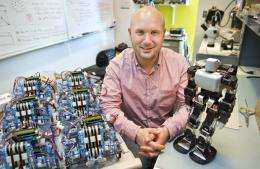Building a better robot

Today’s robots can vacuum floors, build cars and even perform surgery. While not quite on the intelligence level of the Jetsons’ robot maid, Rosie, they are rather smart. Nonetheless, modern robots struggle to handle the common problem of uncertainty in the environment: Move a wrench from a Ford robot’s tool tray, for example, and you risk ruining the whole car. Get a new rug with tassels and your Roomba may as well go back in the closet with the broom.
Marsette Vona, an assistant professor in the College of Computer and Information Science at Northeastern, wants to change all that. Backed by a five-year National Science Foundation (NSF) CAREER Award, Vona plans to merge the two areas of research he has pursued throughout his academic career: 3-D perception and compliant contact.
The goal, he said, is to develop software through which a robot can acquire 3-D information about its surroundings, process the data and then approach the environment with a certain amount of “intelligence.”
As a graduate student at the MIT Media Lab, Vona designed a climbing robot that could grab onto uneven surfaces and adjust its grip based on the dynamics of its initial contact. “It’s helpful for a robot to be ‘soft’— to adjust appropriately based on response,” Vona explained. “Humans do it intrinsically.”
But Vona’s climbing robot and more recent compliant machines are “blind.” In another project, Vona uses cameras to give robots “sight.”
Earlier iterations of this technique use 2-D cameras to extract information about the surroundings. Using the Microsoft Kinnect 3-D camera, however, Vona’s team can analyze the geometry of an environment with the hope of one day coupling that information with compliant contact. By recognizing uneven terrain, for example, robots may soon be able to make a decision about how to approach and touch that surface.
Vona envisions robots that could help amputees traverse rocky trails, perform hazardous tasks in a compromised nuclear reactor surrounded by debris, or move along the sea floor — or even the surface of another planet — with ease.
“We need robots today that can work in hazardous locations with very rough terrain,” Vona said. “In the future we may want robots that can walk with us over stairs, curbs and rocks.
“Understanding how to combine 3-D perception with compliant contact,” he added, “will be a major step towards these goals.”
The research component of Vona’s CAREER award will intersect with his teaching program. He currently teaches Robotic Science and Systems, in which both undergraduate and graduate students team up to write software for and build practical robots that can lift objects off the floor. In the future, Vona hopes to introduce students to the problem of uncertainty in this class.
Provided by Northeastern University




















